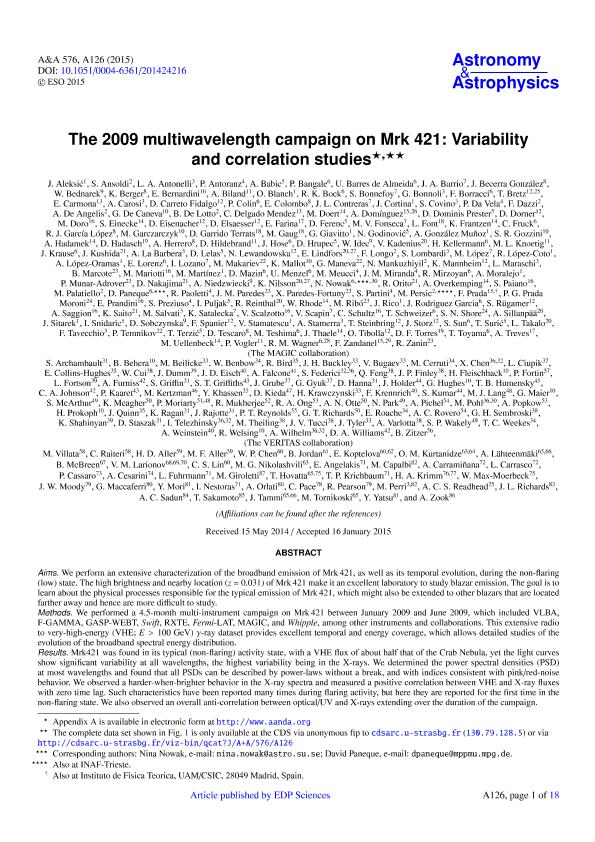Artículo
The 2009 multiwavelength campaign on Mrk 421: Variability and correlation studies
Aleksic, J.; Ansoldi, S.; Antonelli, L. A.; Antoranz, P.; Babic, A.; Bangale, P.; Barres de Almeida, U.; Barrio, J. A.; Becerra Gonzalez, J.; Bednarek, W.; Berger, K.; Bernardini, E.; Bijand, A.; Blanch, O.; Bock, R. K.; Bonnefoy, S.; Bonnoli, G.; Borracci, F.; Bretz, T.; Carmona, E.; Carosi, A.; Carreto Fidalgo, D.; Colin, P.; Colombo, E.; Contreras, J. L.; Cortina, J.; Covino, S.; Pichel, Ana Carolina ; Rovero, Adrian Carlos
; Rovero, Adrian Carlos ; The Magic Collaboration; The Veritas Collaboration
; The Magic Collaboration; The Veritas Collaboration
 ; Rovero, Adrian Carlos
; Rovero, Adrian Carlos ; The Magic Collaboration; The Veritas Collaboration
; The Magic Collaboration; The Veritas Collaboration
Fecha de publicación:
04/2015
Editorial:
Edp Sciences
Revista:
Astronomy And Astrophysics
ISSN:
0004-6361
Idioma:
Inglés
Tipo de recurso:
Artículo publicado
Clasificación temática:
Resumen
Aims: We perform an extensive characterization of the broadband emission of Mrk 421, as well as its temporal evolution, during the non-flaring (low) state. The high brightness and nearby location (z = 0.031) of Mrk 421 make it an excellent laboratory to study blazar emission. The goal is to learn about the physical processes responsible for the typical emission of Mrk 421, which might also be extended to other blazars that are located farther away and hence are more difficult to study. Methods: We performed a 4.5-month multi-instrument campaign on Mrk 421 between January 2009 and June 2009, which included VLBA, F-GAMMA, GASP-WEBT, Swift, RXTE, Fermi-LAT, MAGIC, and Whipple, among other instruments and collaborations. This extensive radio to very-high-energy (VHE; E> 100 GeV) γ-ray dataset provides excellent temporal and energy coverage, which allows detailed studies of the evolution of the broadband spectral energy distribution. Results: Mrk421 was found in its typical (non-flaring) activity state, with a VHE flux of about half that of the Crab Nebula, yet the light curves show significant variability at all wavelengths, the highest variability being in the X-rays. We determined the power spectral densities (PSD) at most wavelengths and found that all PSDs can be described by power-laws without a break, and with indices consistent with pink/red-noise behavior. We observed a harder-when-brighter behavior in the X-ray spectra and measured a positive correlation between VHE and X-ray fluxes with zero time lag. Such characteristics have been reported many times during flaring activity, but here they are reported for the first time in the non-flaring state. We also observed an overall anti-correlation between optical/UV and X-rays extending over the duration of the campaign. Conclusions: The harder-when-brighter behavior in the X-ray spectra and the measured positive X-ray/VHE correlation during the 2009 multi-wavelength campaign suggests that the physical processes dominating the emission during non-flaring states have similarities with those occurring during flaring activity. In particular, this observation supports leptonic scenarios as being responsible for the emission of Mrk 421 during non-flaring activity. Such a temporally extended X-ray/VHE correlation is not driven by any single flaring event, and hence is difficult to explain within the standard hadronic scenarios. The highest variability is observed in the X-ray band, which, within the one-zone synchrotron self-Compton scenario, indicates that the electron energy distribution is most variable at the highest energies.
Palabras clave:
Bl Lacertae Objects: Individual: Mrk 421
Archivos asociados
Licencia
Identificadores
Colecciones
Articulos(IAFE)
Articulos de INST.DE ASTRONOMIA Y FISICA DEL ESPACIO(I)
Articulos de INST.DE ASTRONOMIA Y FISICA DEL ESPACIO(I)
Citación
Aleksic, J.; Ansoldi, S.; Antonelli, L. A.; Antoranz, P.; Babic, A.; et al.; The 2009 multiwavelength campaign on Mrk 421: Variability and correlation studies; Edp Sciences; Astronomy And Astrophysics; 576; 4-2015; A126,1-18
Compartir
Altmétricas



